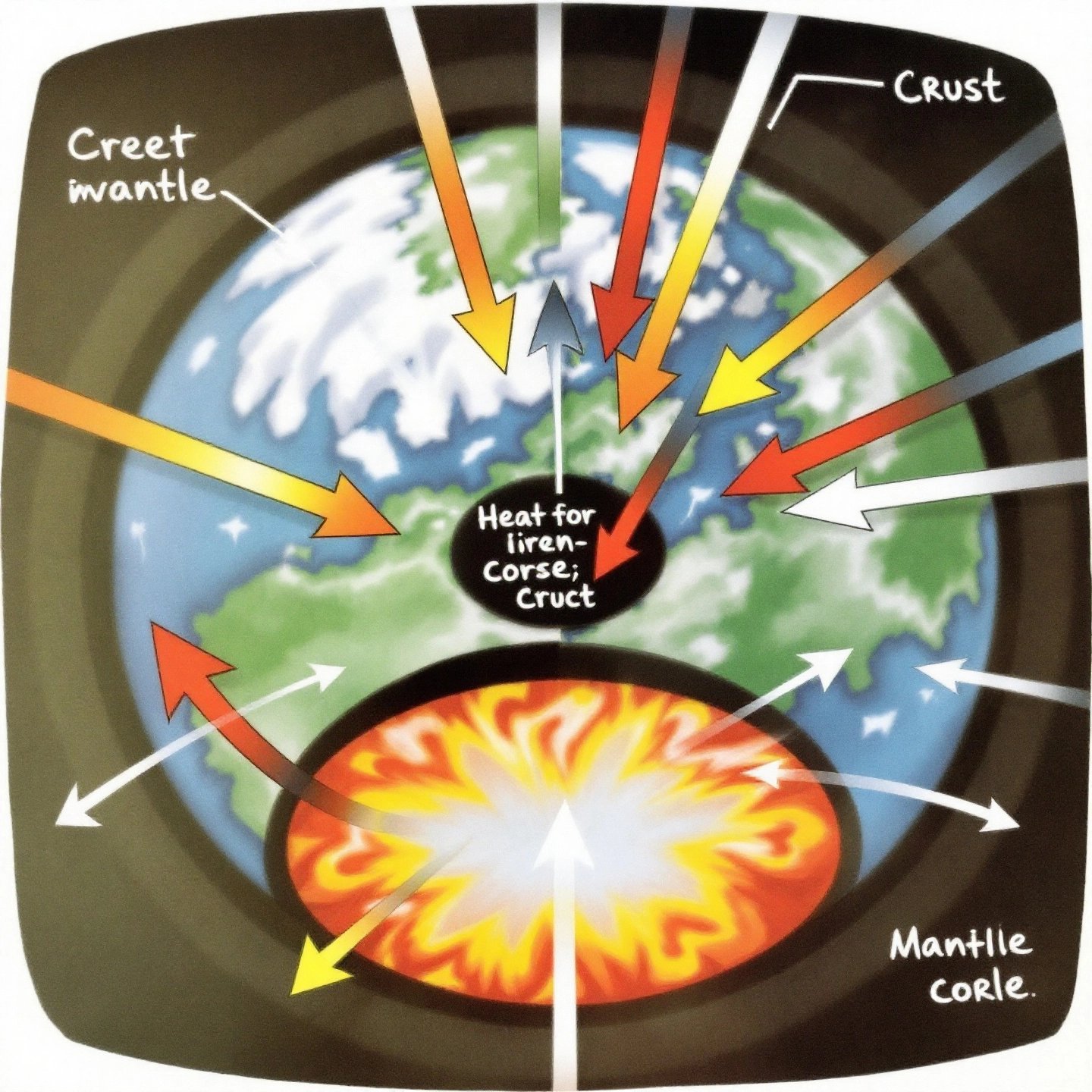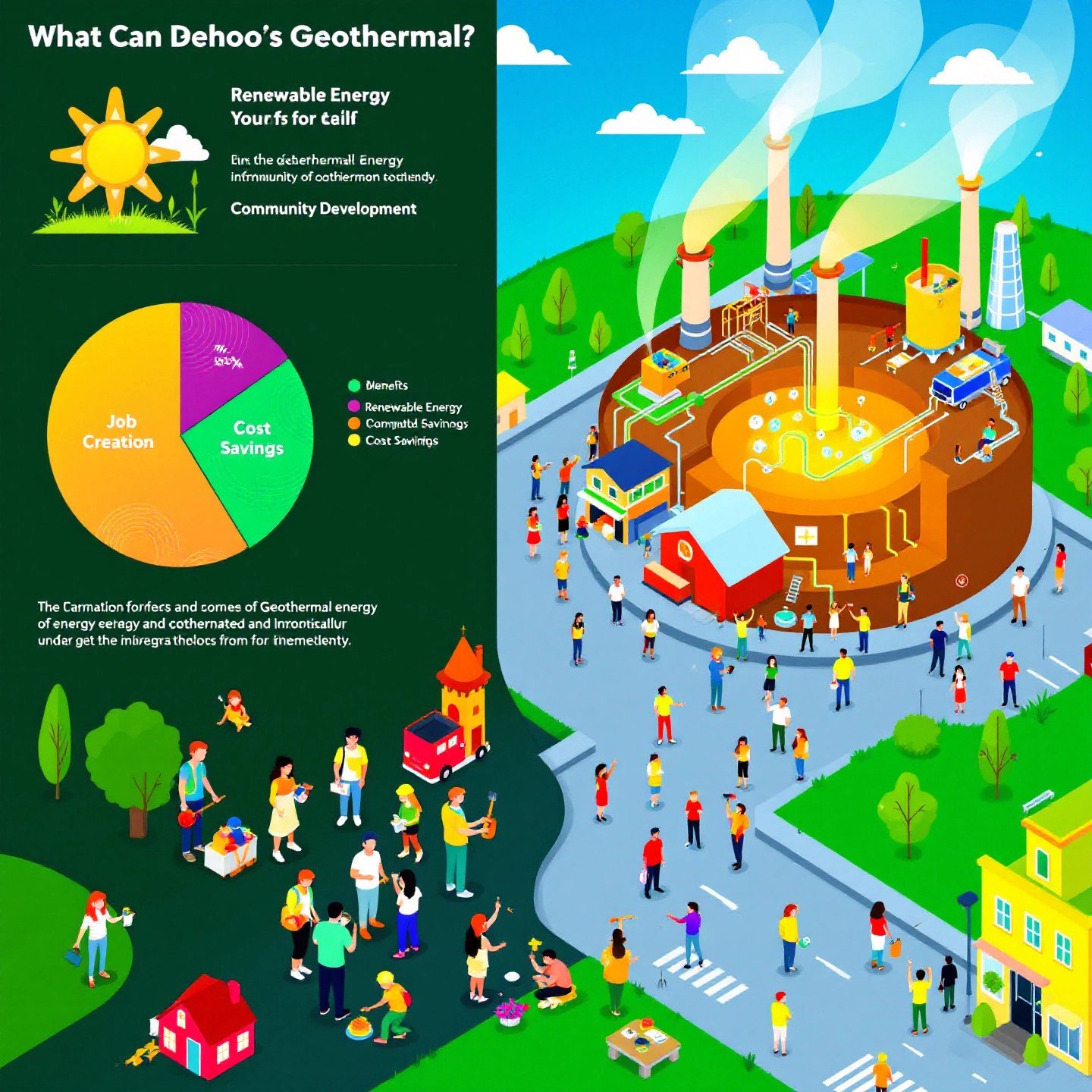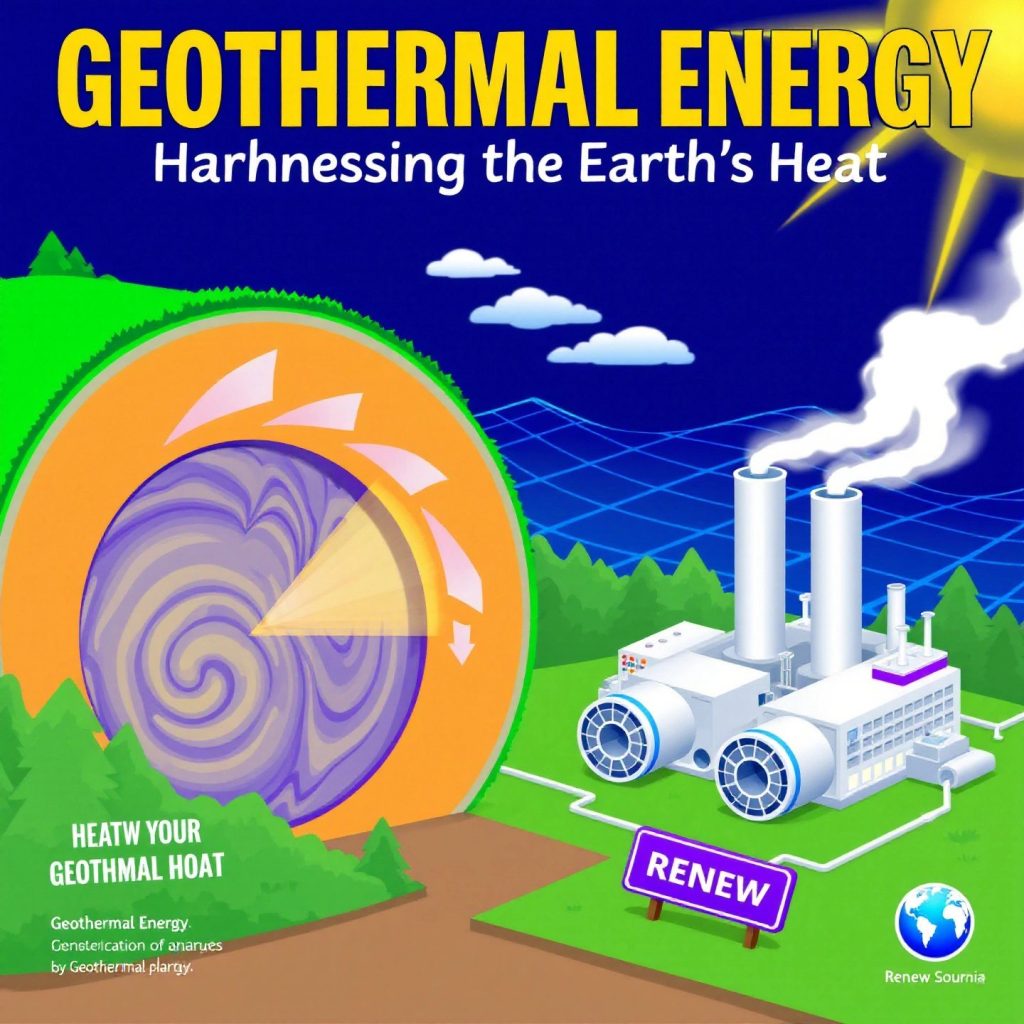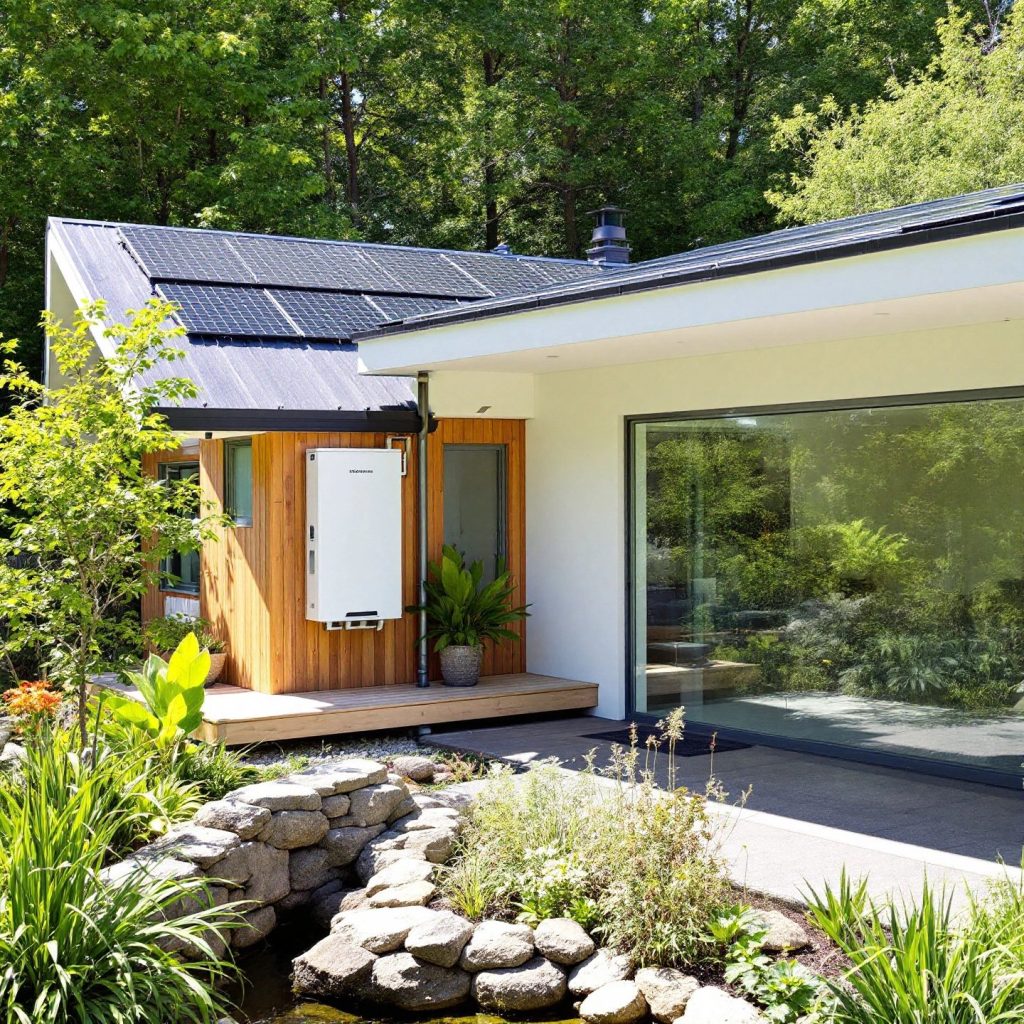Introduction to Geothermal Energy: A Renewable Power Source?
When considering sustainable power solutions, one might ask, “Is geothermal energy renewable?” This question is more than just academic curiosity; it’s crucial for those seeking viable alternatives to fossil fuels. Geothermal energy, derived from the Earth’s internal heat, holds promise as a clean and sustainable energy source. But what does it mean for an energy source to be renewable, and where does geothermal fit into this picture?
In this article, we will delve into the renewable nature of geothermal energy from both scientific and practical perspectives. We will explore how geothermal energy is continuously replenished by the natural decay of radioactive elements in the Earth’s core, providing a virtually inexhaustible supply of heat (source). Additionally, we’ll consider the practical aspects, such as the efficiency and reliability of geothermal power plants. These plants can operate 24/7, offering a stable energy supply that complements intermittent sources like wind and solar.
Understanding geothermal energy’s renewable potential is vital for anyone interested in clean energy solutions. As we compare geothermal energy with other sources, such as solar and wind, we’ll highlight the unique benefits and challenges it presents. This exploration will provide a comprehensive look at why geothermal energy deserves a prominent place in discussions about sustainable energy strategies. Join us as we uncover the facts and dispel the myths surrounding this fascinating energy source.

Understanding the Basics of Geothermal Energy
Geothermal energy, a term derived from the Greek words ‘geo’ (earth) and ‘therme’ (heat), refers to the heat generated and stored within the Earth. This energy originates from the planet’s formation and the radioactive decay of minerals, providing a continuous and sustainable heat supply. But where exactly does this heat come from, and how do we tap into it?
Imagine the Earth as a giant, layered cake. At its core lies a solid iron center, surrounded by a molten outer core, a mantle of hot, viscous rock, and a solid crust on top. The heat from the core and mantle rises through these layers, sometimes reaching the surface in the form of hot springs, geysers, or volcanic activity. These geothermal energy sources are not only spectacular natural phenomena but also valuable resources for energy extraction.
Harnessing Geothermal Energy
Throughout history, humans have utilized geothermal energy in various ways. Ancient civilizations, such as the Romans, used hot springs for bathing and heating. Today, we harness geothermal energy primarily through geothermal power plants and direct heating systems. Geothermal power plants convert heat from the Earth’s interior into electricity. These plants are often located in regions with high geothermal activity, like Iceland and parts of the United States, where the Earth’s heat is more accessible.
There are several types of geothermal power plants, including dry steam, flash steam, and binary cycle plants. Dry steam plants use steam directly from geothermal reservoirs to drive turbines, while flash steam plants pull high-pressure hot water from the ground, allowing it to vaporize into steam. Binary cycle plants, on the other hand, transfer heat to a secondary fluid with a lower boiling point than water, which then vaporizes to drive a turbine. Each of these methods leverages different geothermal energy sources to generate power efficiently.
Modern Applications
Beyond electricity generation, geothermal energy is used for direct heating applications. Geothermal heat pumps, for example, exploit the stable temperatures just below the Earth’s surface to heat and cool buildings. This technology provides a reliable and eco-friendly alternative to traditional heating and cooling systems.
As we continue to explore and develop geothermal energy sources, we unlock a cleaner, more sustainable future. By understanding the basics of geothermal energy, we can appreciate its potential as a cornerstone of renewable energy solutions, complementing other green technologies and helping to reduce our reliance on fossil fuels.
Examining the Distinctions Between Renewable and Nonrenewable Sources
To truly appreciate the potential of geothermal energy, it’s essential to understand the broader context of energy resources. The terms renewable and nonrenewable describe how energy sources are classified based on their availability and replenishment rates. Renewable resources, like solar and wind, are naturally replenished on a human timescale, while nonrenewable resources, such as coal and oil, exist in finite quantities and take millions of years to form.
So where does geothermal energy fit in? Geothermal energy is generally considered renewable because it harnesses the Earth’s internal heat, which is continuously replenished by the natural decay of radioactive elements in the Earth’s core. This heat flow is constant and vast, making geothermal energy a sustainable resource over the long term. However, the debate arises due to the localized depletion of geothermal resources if not managed properly. This is where the concept of geothermal field management comes into play, ensuring that the extraction does not exceed the natural replenishment rate.
Comparing Characteristics
To clarify these distinctions, consider the following characteristics:
| Characteristic | Renewable Resources | Nonrenewable Resources |
|---|---|---|
| Availability | Unlimited, naturally replenished | Limited, finite supply |
| Replenishment Rate | Fast (e.g., sunlight, wind) | Slow (e.g., fossil fuels) |
| Environmental Impact | Generally low, though site-specific impacts may occur | High, due to extraction and combustion |
| Geothermal Energy | Renewable, with sustainable management | Debated in specific contexts |
Geothermal energy’s classification as renewable is supported by its ability to provide a constant energy supply, as long as the rate of heat extraction is balanced with the natural heat flow. This requires careful management and monitoring of geothermal fields to prevent overexploitation.
Understanding these distinctions helps clarify why geothermal energy is often grouped with other renewable resources. As we move forward, it’s crucial to consider not only the scientific basis for these classifications but also the practical implications for energy policy and sustainability. This understanding sets the stage for exploring the core reasons geothermal power is labeled as renewable, which we’ll delve into next.
Uncovering the Core Reasons Geothermal Power Is Labeled as Renewable
Imagine a limitless power source, constantly replenished by the Earth itself. That’s the essence of geothermal energy. But why is geothermal energy renewable? The answer lies in the Earth’s natural processes. Geothermal energy is primarily derived from the Earth’s core heat, which is consistently generated through the decay of radioactive elements. This process ensures a continuous supply of heat energy, making geothermal power a sustainable resource over the long term.
Scientific Foundations of Renewability
Geothermal energy is considered renewable due to the vast heat reservoir within the Earth. As Dr. Drew L. Siler, a geothermal geologist, explains, the Earth’s heat is not only a remnant from its formation but is also constantly replenished by radioactive decay (source). This constant heat flow ensures that the energy extracted for human use is a mere fraction of the total heat available, reinforcing its renewable status.
Moreover, geothermal systems often benefit from natural water recharge cycles. These cycles help maintain fluid levels and pressure in geothermal reservoirs, essential for sustainable energy extraction. However, this does not mean geothermal energy is entirely free from challenges. Localized depletion can occur if extraction surpasses the natural recharge rate. This is where geothermal field management becomes crucial.
Effective Management for Sustainability
Effective management techniques play a vital role in maintaining geothermal energy’s renewability. By carefully monitoring and managing geothermal fields, operators can ensure that the extraction rates align with the natural replenishment processes. Techniques such as re-injecting extracted fluids back into the reservoir help maintain pressure and temperature levels, thereby extending the life of geothermal fields.
Despite these management strategies, some argue that geothermal energy’s renewability is context-dependent. In areas where geothermal fields are not adequately managed, resources can become depleted, leading to reduced energy output over time. However, with proper field management and technological advancements, these challenges can be mitigated, securing geothermal energy as a reliable and renewable energy source.
Understanding these scientific and environmental arguments underscores why geothermal energy is labeled as renewable. By leveraging the Earth’s natural heat and employing effective field management, geothermal power can contribute significantly to sustainable energy solutions. As we explore further, we will see how these principles translate into practical applications and benefits.
Revealing How Geothermal Heat Replenishes Itself
Geothermal energy’s renewability hinges on the continuous heat flow from the Earth’s interior, driven by both primordial and radiogenic heat. This internal heat is a result of the Earth’s formation and ongoing radioactive decay, which maintains a steady thermal gradient within the planet. But how exactly does this heat make its way to the surface, and how do we harness it sustainably?
Understanding Earth’s Internal Heat Flow
The Earth’s internal heat is primarily transported to the surface through conduction and convection. Conduction occurs as heat moves through solid materials, such as rocks in the Earth’s crust. Convection, on the other hand, involves the movement of heated fluid masses within the mantle, allowing for the transfer of heat to cooler regions. This process is critical, as it ensures a continuous supply of geothermal energy by cycling heat from the depths to the surface (source).
As heat from the Earth’s interior travels upward, it can be captured by geothermal systems. In areas with significant geothermal activity, such as hot springs and geysers, this heat is more accessible. Geothermal power plants are strategically located in these regions to tap into this readily available resource.
The Role of Water Recharge Cycles
Water recharge cycles play an essential role in maintaining geothermal systems. These cycles involve the natural replenishment of water in geothermal reservoirs, which is crucial for sustaining pressure and temperature levels necessary for energy extraction. When geothermal fluids are extracted, they often undergo a process of re-injection, where used fluids are returned to the reservoir. This practice helps preserve the geothermal field’s viability by maintaining the delicate balance of heat and fluid levels (source).
Responsible Extraction Practices
Responsible extraction practices are vital to ensuring the long-term sustainability of geothermal energy. Operators must carefully monitor the extraction rates to align with the natural replenishment processes. By employing technologies that optimize heat and fluid management, geothermal energy can be extracted without depleting the resource.
Through understanding these scientific processes and implementing effective management techniques, geothermal energy remains a reliable and renewable resource. As we continue to advance our knowledge and technology, the potential for geothermal energy to contribute to global energy solutions grows, reinforcing its role in a sustainable future.

Exploring Real-World Applications of Geothermal Resources
Imagine tapping into the Earth’s natural heat to power homes, industries, and even entire cities. Geothermal energy makes this possible through a variety of applications that highlight its versatility and sustainability. But how exactly is geothermal energy used in the real world, and what makes it a compelling choice for clean energy solutions?
Geothermal Electricity Generation
One of the primary applications of geothermal energy is electricity generation. Geothermal power plants harness the Earth’s heat to produce electricity, providing a stable and continuous energy supply. Unlike solar or wind, geothermal power is not dependent on weather conditions, making it a reliable energy source. The United States, for instance, has several geothermal power plants, contributing significantly to its renewable energy mix. In 2023, geothermal power plants in the U.S. produced about 0.4% of the total utility-scale electricity generation (source).
District Heating and Beyond
Beyond electricity, geothermal energy is used in district heating systems, where hot water from geothermal sources is piped directly into buildings for heating. This application is particularly prevalent in Iceland, where geothermal energy supplies heat to most of Reykjavik’s buildings. This method of heating is not only efficient but also reduces reliance on fossil fuels, showcasing geothermal energy’s potential in urban settings.
Geothermal energy also finds applications in agriculture, such as greenhouse heating. By maintaining optimal temperatures, geothermal heat enables year-round cultivation, even in colder climates. This application is evident in New Zealand, where geothermal resources are used to heat greenhouses, allowing for the production of crops that would otherwise be impossible to grow in certain seasons.
Notable Geothermal Power Plants
- The Geysers, California, USA: The largest dry steam geothermal complex in the world, generating around 900 MW of electricity.
- Wairakei Power Station, New Zealand: An early adopter of flash steam technology, with a capacity of approximately 180 MW.
- Nesjavellir Power Station, Iceland: Provides both electricity and hot water for district heating, illustrating the dual benefits of geothermal energy.
These examples demonstrate the diverse applications and benefits of geothermal power, highlighting its role as a cornerstone of sustainable energy solutions. As technology advances, the synergy between geothermal and other renewable sources, like solar and wind, can further enhance energy systems, paving the way for a more sustainable future.
Recognizing the Environmental Benefits of Geothermal Utilization
When considering energy sources that harmonize with our planet, geothermal energy stands out due to its minimal environmental impact. But what makes it so eco-friendly? Let’s explore the environmental benefits of geothermal energy and the potential challenges it presents.
Eco-Friendly Attributes
Geothermal energy is renowned for its low emissions. Unlike fossil fuels, geothermal power plants do not burn fuel to generate electricity, which significantly reduces the release of harmful gases. According to the U.S. Energy Information Administration, geothermal plants emit 97% less sulfur compounds and 99% less carbon dioxide compared to similar-sized fossil fuel plants (source). This makes geothermal energy a critical player in reducing greenhouse gas emissions and combating climate change.
Additionally, geothermal energy requires a relatively small land footprint. Unlike solar farms or wind turbines, geothermal plants can generate substantial amounts of energy from compact sites. This efficiency minimizes land disruption, preserving natural habitats and biodiversity.
- Low Emissions: Significantly reduced sulfur and carbon dioxide emissions compared to fossil fuels.
- Small Land Footprint: Efficient energy generation with minimal land use.
- Long-Term Sustainability: Continuous heat supply from the Earth’s core ensures a sustainable energy source.
Potential Environmental Challenges
Despite its benefits, geothermal energy is not without challenges. One concern is the potential for seismic activity. Enhanced geothermal systems, which involve injecting water into hot rock formations, can sometimes trigger minor earthquakes. While these events are typically small and occur away from populated areas, they highlight the need for careful site selection and monitoring (source).
Another consideration is the management of geothermal fluids. While most geothermal plants re-inject used fluids back into the earth to sustain the reservoir, this process must be carefully managed to prevent contamination of groundwater sources.
In conclusion, geothermal energy offers substantial environmental advantages, making it a promising component of a sustainable energy future. By addressing its challenges with responsible management and technological advancements, geothermal energy can continue to provide clean, reliable power with minimal environmental impact.

Considering the Economic Advantages of Geothermal Projects
Imagine a world where energy costs are stable, jobs flourish, and communities thrive. Sounds promising, right? This is the potential reality with geothermal energy projects. Geothermal energy presents numerous economic benefits that extend beyond just providing clean power. But what exactly are these advantages, and how do they compare to other renewable energy sources?
Stability and Cost Savings
One of the significant economic benefits of geothermal energy is its cost stability. Unlike fossil fuels, which are subject to price volatility, geothermal energy offers predictable pricing. This stability is especially valuable for long-term planning and budgeting, making it an attractive option for businesses and governments alike. The upfront costs of developing geothermal projects can be high, but the long-term savings are substantial. Geothermal power plants have low operating costs and can produce electricity at a lower cost over their lifespan compared to traditional energy sources (source).
Job Creation and Community Development
Geothermal projects are also a boon for job creation. According to a brief by the U.S. Geothermal Energy Association, geothermal power plants employ about 1.17 persons per megawatt (MW) during operation, significantly higher than other renewable sources like wind and solar. This employment is stable and long-term, lasting the entire 30-50 year lifespan of a power plant (source). Additionally, the construction phase of geothermal plants requires substantial labor, further boosting local economies.
Beyond employment, geothermal projects contribute to community development through tax revenues and royalties. In the U.S., geothermal power producers paid millions in property taxes and rents, benefiting state and local governments. This financial influx supports public services and infrastructure improvements, enhancing the quality of life for residents.
Evaluating Investment Returns
For investors, geothermal energy projects offer attractive returns. The average internal rate of return (IRR) for geothermal projects ranges from 10 to 16 percent, reflecting their financial viability. As the demand for clean, baseload energy increases, these returns are expected to rise, making geothermal a lucrative investment (source). Platforms like Renewable Energy Nexus provide valuable insights into evaluating investment returns for geothermal and solar panels, helping investors make informed decisions.
In conclusion, geothermal energy projects offer significant economic advantages, from cost savings and job creation to community benefits and investment opportunities. By leveraging these strengths, geothermal energy can play a pivotal role in driving economic growth while supporting a sustainable future. As we look ahead, understanding these economic benefits will be crucial for maximizing the potential of geothermal resources.
Looking Ahead to the Future of Geothermal Sustainability
As the world increasingly turns to renewable energy, geothermal power stands poised to play a significant role in our sustainable future. But what does the future hold for geothermal energy, and how can emerging technologies and innovations expand its capabilities?
Innovative Drilling Technologies
The future of geothermal energy is bright, thanks in part to groundbreaking advancements in drilling technology. One such innovation is the development of gyrotron drills, which have the potential to revolutionize how we access geothermal resources. These high-powered drills, utilizing microwave technology, can vaporize rock, allowing for deeper and more efficient access to the Earth’s intense heat (source). This could significantly expand the geographical areas where geothermal energy is viable, making it accessible beyond traditional hotspots like Iceland.
Technological Synergies and Environmental Awareness
Geothermal energy’s future is also tied to its integration with other renewable technologies. By combining geothermal with solar or wind, energy systems can become more resilient and efficient, offering a stable power supply even when weather conditions vary. This synergy not only enhances energy reliability but also supports broader environmental goals by reducing reliance on fossil fuels.
In addition, growing environmental awareness is driving demand for cleaner energy solutions. As societies recognize the importance of reducing carbon footprints, geothermal energy’s low emissions and sustainable nature make it an attractive option. Policies and incentives from governments worldwide are likely to further encourage geothermal development, providing financial support for research and infrastructure projects.
Governmental Incentives and Future Prospects
Governmental incentives play a crucial role in the expansion of geothermal energy. Many countries are implementing policies that support renewable energy projects, including tax credits, grants, and low-interest loans for geothermal development. These incentives not only lower the financial barriers to entry but also stimulate innovation in the sector.
Looking ahead, anticipated advances in drilling techniques and geothermal technology promise to unlock even more potential. As we refine our understanding of geothermal systems and improve our ability to harness Earth’s heat, geothermal energy is set to become a cornerstone of the renewable energy landscape. The ongoing collaboration between governments, industries, and research institutions will be key to achieving this vision, ensuring geothermal energy’s place in a sustainable future.
As we continue to explore geothermal energy’s potential, it’s clear that innovation and collaboration will drive its growth. With the right support and technological advancements, geothermal energy can provide a reliable, clean energy source for generations to come.
Conclusion
As we reach the conclusion of our exploration into geothermal energy, it’s clear why this energy source is broadly recognized as renewable. Geothermal energy harnesses the Earth’s internal heat, a resource continuously replenished by natural processes such as the decay of radioactive elements. This constant energy flow ensures geothermal power remains a sustainable choice for generations to come.
In comparing geothermal energy with other renewable sources like solar and wind, its unique ability to provide a stable and reliable energy supply stands out. Unlike solar and wind, which are subject to weather conditions, geothermal energy can deliver consistent power, making it an excellent complement to these intermittent sources. This synergy is crucial as we strive for a diversified and resilient energy mix.
Moreover, geothermal energy’s minimal environmental footprint, with low emissions and a small land use, reinforces its role in a sustainable energy future. By integrating geothermal with other green technologies, we can enhance our efforts to reduce carbon emissions and combat climate change.
As you consider your clean energy options, platforms like Renewable Energy Nexus offer invaluable resources for exploring diversified clean energy investments. Whether you’re interested in geothermal, solar, or other renewable technologies, these resources can guide you towards making informed decisions that align with both environmental goals and economic benefits.
In summary, geothermal energy not only holds the promise of a sustainable future but also provides a reliable and efficient energy solution today. By embracing this renewable resource alongside other green technologies, we can pave the way for a cleaner, more sustainable world.
Frequently Asked Questions
1. Could geothermal energy run out?
Geothermal energy is considered inexhaustible on a human timescale because the Earth’s internal heat is continuously replenished by radioactive decay. However, localized resource depletion can occur if geothermal fields are not managed sustainably.
2. How does geothermal energy compare to solar and wind?
Geothermal energy provides a stable, 24/7 power supply, unlike solar and wind, which are weather-dependent. This makes it a reliable complement to other renewable sources in a diversified energy mix.
3. What are the environmental benefits of geothermal energy?
Geothermal energy has low emissions and a small land footprint, making it eco-friendly. It emits significantly less carbon dioxide and sulfur compounds compared to fossil fuels, contributing to climate change mitigation.
4. What economic benefits do geothermal projects offer?
Geothermal projects provide cost stability, job creation, and community benefits through tax revenues and royalties. They offer long-term savings despite high initial costs, making them economically advantageous.
5. What are the future prospects for geothermal energy?
Advancements in drilling technology and increased environmental awareness are expanding geothermal’s potential. Government incentives are also driving growth, making geothermal a promising player in the renewable energy landscape.



